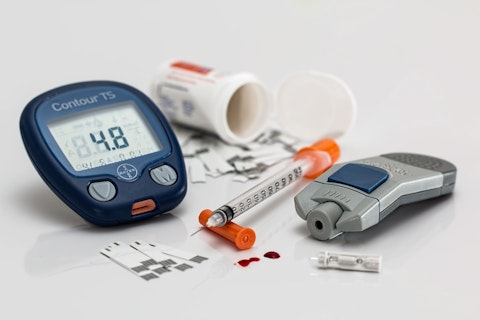In this article, we will be taking a look at the 32 countries with the highest rates of diabetes. If you do not want to learn about the global diabetes market, head straight to the 5 Countries with the Highest Rates of Diabetes.
The Global Diabetes Market and Its Implications
The global diabetes market is experiencing significant growth and poses a substantial challenge to public health worldwide. According to the IDF Diabetes Atlas, in 2021, approximately 537 million people were suffering from diabetes globally, a number expected to rise to 643 million by 2030 and 783 million by 2045. This increase in prevalence underscores the urgent need for effective measures to address this chronic disease.
In the United States, the diabetes market is substantial, with around 136 million adults diagnosed with diabetes or in a prediabetic condition as reported by the Centers for Disease Control and Prevention. The U.S. market is dominated by key players such as Abbott, Medtronic, Dexcom, and Insulet Corporation. North America held a significant share of the global diabetes devices market at 38.66% in 2022, driven by a large patient population and favorable reimbursement conditions.
Financially, the global diabetes devices market was estimated at USD 30.31 billion in 2023 and is projected to grow at a compound annual growth rate of 7.45% from 2024 to 2030, reaching USD 32.70 billion. North America led this market in 2022, reflecting the region’s high patient numbers and supportive reimbursement environment. Key factors propelling market growth include increasing diabetes incidence, technological advancements in preventive care, and rising demand for blood glucose monitoring devices.
The Diabetic Dilemma: A Global Economic Crisis
The global diabetes epidemic looms large, claiming over 280,000 lives annually. Government initiatives and the development of affordable drugs like oral hypoglycemics are driving market expansion. The toll of diabetes contributes significantly to the global disease burden, estimated at a staggering $16.3 trillion over two decades. Insulin, a lifeline for millions worldwide, experiences soaring demand, particularly in emerging economies. Notably, 94% of insulin pump users reported enhanced quality of life in 2023, fostering robust growth in the insulin pump market, projected to reach $11.4 billion by 2032, growing at an 8.5% CAGR.
In the United States, insulin costs have surged by over 600% in the last two decades, leading one in four diabetics to ration their supply due to financial constraints. However, investing in affordable options such as biosimilars and generics can alleviate this burden. Major pharmaceutical giants like Sanofi, Eli Lilly and Company, and Novo Nordisk have the potential to mitigate the financial strain on patients and healthcare systems alike. In 2017 alone, diabetes inflicted a staggering 327 billion blow to the US economy, with direct medical expenses totaling $237 billion. Laboratory costs for diabetes management vary widely, ranging from under $5 to over $100 per patient annually.
Sanofi (NASDAQ:SNY), a leading global healthcare company with a century-long legacy, has been instrumental in advancing diabetes treatment and management. Their commitment to developing cutting-edge treatments like TZIELD for Stage 3 type 1 diabetes demonstrates their dedication to enhancing health outcomes. Additionally, their exploration of AI-driven systems for blood glucose analysis reflects a commitment to individualized diabetes support. In Q4 2023, despite a 5% decrease in operating income attributed to various factors, Sanofi (NASDAQ:SNY) experienced significant sales growth, particularly with the anti-inflammatory drug Dupixent. Sanofi (NASDAQ:SNY) anticipates a rebound in adjusted earnings per share in 2025 following a slight decline in 2024. Additionally, Sanofi announced a new chief financial officer, Francois-Xavier Roger, from Nestle, effective April 1, succeeding Jean-Baptiste de Chatillon.
Novo Nordisk A/S (NYSE:NVO), a leading player in the diabetes market, has strengthened its position with a market share increase to 54.9% in 2022. The company dominates the global insulin market with nearly 50% share by volume. Novo Nordisk A/S (NYSE:NVO)’s success lies in innovative products like Ozempic and Wegovy, driving impressive sales growth and enabling it to address unmet needs in type 2 diabetes and obesity.
Anticipating continued growth, Novo Nordisk A/S (NYSE:NVO) expects sales to increase by 18% to 26% this year, fueled by demand for key products. Despite competition, especially in the weight loss segment, the company is confident in meeting market demands through strategic investments.

Our Methodology
For our methodology, we have ranked the countries with the highest rates of diabetes based on age-standardized diabetes rates in these countries in 2021. For the accuracy of data, we relied on IDF Diabetes Atlas.
Here is our list of the 32 countries with the highest rates of diabetes.
32. Bangladesh
Diabetes Rate: 14.2%
In Bangladesh, diabetes prevalence has surged from 4.5% to 35% between 1994 and 2013. In 2019, 8.4 million adults had diabetes, projected to double by 2045. Prevalence among adults aged 35+ rose from 10.95% in 2011 to 13.75% in 2018, notably among obese individuals. Both genders are affected equally, with prevalence increasing with age.
31. Belize
Diabetes Rate: 14.5%
Belize faces a severe health challenge with a high prevalence of type 2 diabetes (T2D), reaching over 17% in adults, making it the highest in Central and South America and the fifth globally. T2D is now the leading cause of death in Belize, with 33% of the population in the prediabetes range. Diabetes affects both genders, primarily adults aged 20 to 79.
30. Turkey
Diabetes Rate: 14.5%
Turkey has diabetes prevalence of around 14.5% among adults aged 20 to 79, showing an increasing trend from 12.2% in 2014 to 13.2% in 2016. Women represent about three in five cases, with a prevalence of 13.10% compared to 9.12% in men. The diabetes therapeutics market is expected to grow to $2.5 billion by 2030, with Nobel İlaç, Koçak Farma, and GlaxoSmithKline as key players.
29. Syria
Diabetes Rate: 14.9%
Syria stands among the countries with the highest rates of diabetes, totaling 2,918,314 individuals affected. In 2017, adult diabetes cases numbered 705,700, with 12.6% prevalence in females and 11.2% in males. Approximately 400,000 Syrians rely on insulin for survival due to diabetes. Prevalence in Aleppo before 2011 was 14.8% among adults over 25. A cross-sectional survey of Syrian refugees in Jordan found a 5.3% prevalence, with higher rates among those over 60.
28. Tonga
Diabetes Rate: 15%
In Tonga, 15% of the population faces diabetes, making Tonga stand among the countries with the highest diabetes rates globally. Diabetes predominantly affects adults, especially those aged 41-60. Nearly all Tongans aged 18–69 are at risk for non-communicable diseases, including diabetes.
27. Jordan
Diabetes Rate: 15.4%
Jordan grapples with a diabetes challenge, with an estimated 866,500 cases in 2021 projected to rise to 1,629,100 by 2045. Diabetes-related health expenditure was USD 849.8 million in 2021, rising to USD 1,234.2 million by 2045, with per capita spending increasing significantly. The most affected age group is 20-79.
26. Micronesia
Diabetes Rate: 15.6%
The Federated States of Micronesia (FSM) stands among the top countries with high rates of diabetes, with a staggering 15.6% prevalence rate as of 2021, attributed to lifestyle changes and a shift to processed foods. Both genders and various age groups are affected. Access to insulin and diabetes treatment is hindered by remoteness, limited healthcare infrastructure, and financial constraints.
25. Vanuatu
Diabetes Rate: 15.6%
In Vanuatu, diabetes affects 1 in 11 people. Both men and women are impacted. Children are also affected by type 1 diabetes, with 10.9% going undiagnosed, emphasizing the need for early detection and improved healthcare services.
24. Saint Kitts and Nevis
Diabetes Rate: 16.1%
Saint Kitts and Nevis stand among the countries with the highest rates of diabetes, with a prevalence rate of 16.9%, concentrated in the 45-64 age group, affecting both genders similarly. Comorbidities are prevalent among diabetics, with 76% experiencing additional health issues. By 2045, the North American and Caribbean region, including St. Kitts and Nevis, is projected to have 63 million diabetes cases.
23. United Arab Emirates
Diabetes Rate: 16.4%
The United Arab Emirates (UAE) has a diabetes prevalence rate of 12.3% among adults, totaling around 990,900 cases. In the Northern Emirates, UAE citizens exhibit a 25.1% prevalence. Diabetes prevalence is highest among UAE nationals and Asian non-Arabs, with males at 21% and females at 23%. Healthcare expenditure on diabetes was USD 2,090.4 million in 2021, projected to rise to USD 2,329.3 million by 2030, equating to USD 2,109.5 per person in 2021, and expected to reach USD 2,350.6 per person by 2030.
22. Papua New Guinea
Diabetes Rate: 16.7%
Papua New Guinea faces significant diabetes prevalence, with 14.6% of adults affected, totaling approximately 724,000 cases. Even rural areas report high rates, with a village study showing 8.9% diabetes and 5.7% impaired glucose tolerance. Both genders are impacted, with middle-aged individuals, aged 30 to 69, bearing the highest burden of diabetes-related mortality and cases.
21. Mexico
Diabetes Rate: 16.9%
Mexico had a diabetes prevalence rate of 16.9% in 2021, impacting around 14 million adults, making Mexico stand among the countries with the highest rates of diabetes. Additionally, 11 million adults have impaired glucose tolerance. Females have a higher risk of diabetes. Diabetes care clinics like Clinicas del Azucar provide affordable care, supported by investments aiming to establish 100 new clinics by 2024.
20. Palau
Diabetes Rate: 17%
Palau faces significant diabetes challenges, with 22% of adults diagnosed, totaling 3,015 individuals, and 66% undiagnosed. Financially, insurance contributions and investments totaled $10.5 million in 2023, but medical care payouts were $7.3 million, indicating strain on the system.
19. Fiji
Diabetes Rate: 17.7%
Fiji stands among the top countries with high rates of diabetes, with prevalence steadily increasing from 16% in 2011 to 17.7% in 2021, projected to reach 20.7% by 2045. The number of diabetes cases is rising, estimated at 99.2 thousand in 2021, and projected to reach 139.7 thousand by 2045. Diabetes affects both genders and various age groups, with a rapid rise attributed to factors like childhood obesity, gestational diabetes, and social transitions, particularly affecting individuals under 60.
18. Saudi Arabia
Diabetes Rate: 18.7%
Saudi Arabia grapples with high diabetes rates, with a prevalence of 17.7% in adults, totaling 4,274,100 cases. Males have a slightly higher prevalence than females, and the highest prevalence is among individuals aged 60 and above. The country faces a significant economic burden due to diabetes, with healthcare expenditure reaching $7,459.5 million in 2021, and a projected national burden exceeding $0.87 billion, excluding indirect costs.
17. Sudan
Diabetes Rate: 18.9%
Sudan faces with a national diabetes prevalence of 7.7% in adults projected to increase to 10.8% by 2035. Type 2 diabetes mellitus (T2DM) is particularly concerning, with a prevalence of 20.8% in eastern Sudan. Insulin plays a crucial role in treatment, especially for youth with T2DM, alongside medications like metformin, glibenclamide, glimepiride, and glipizide.
16. Malaysia
Diabetes Rate: 19%
In Malaysia, approximately 18.3% of adults were affected by diabetes, according to the National Diabetes Registry Report. The prevalence has steadily increased from 13.4% in 2015 to 18.3% in 2019. Elderly individuals, especially those aged 60 and above, bear the highest burden, with rates reaching 33.46%. Ethnic disparities exist, with Indians having the highest prevalence at 25.10%. Despite a high treatment rate of 87.5%, only 21.8% of treated individuals have their diabetes under control, indicating a need for improved management strategies.
15. Guam
Diabetes Rate: 19.1%
Guam had a diabetes prevalence rate of 19.1% in 2021, up from 13.7% in 2018. Approximately one in six residents is affected, with the indigenous Chamorro population experiencing higher rates. Individuals aged 45 and older are at higher risk, raising concerns due to Guam’s relatively young population.
14. Qatar
Diabetes Rate: 19.5%
Qatar faces a significant challenge with diabetes, with a prevalence of around 19.5%, expected to rise to 24% by 2050, making Qatar stand among the top countries with high rates of diabetes. The SMART clinic provides tailored care plans, emphasizing blood glucose, pressure, and lipid levels.
13. Solomon Islands
Diabetes Rate: 19.8%
The Solomon Islands had a diabetes prevalence rate of 19.8% in 2021. Both genders and various age groups are affected, with adults aged 30 to 69 being the most impacted. Despite the high prevalence, insulin usage remains low at approximately 6%, indicating a need for improved management strategies.
12. Tuvalu
Diabetes Rate: 20.3%
Tuvalu, a Pacific island nation, had a diabetes prevalence rate of 20.3%. Females have a slightly higher prevalence at 23.8% compared to males at 22.4%. The remote location and scarce healthcare facilities hinder access to essential treatments, including insulin, exacerbating the challenge of controlling the disease.
11. American Samoa
Diabetes Rate: 20.3%
American Samoa faces one of the world’s highest rates of diabetes, particularly among adults aged 20 to 79. The prevalence of Type 2 diabetes mellitus has been steadily increasing over the years, with projections indicating further escalation. Adults aged 25 to 64 have witnessed a significant rise in Type 2 diabetes prevalence, highlighting a growing health challenge in this age group.
10. Egypt
Diabetes Rate: 20.9%
Egypt faces a significant challenge with diabetes, with a prevalence rate of approximately 15.2% among adults. The number of adult diabetic patients was around 8,850,400 in early 2020 and is expected to rise significantly by 2035. Type 2 diabetes prevalence is approximately 15.6% among adults aged 20 to 79.
9. Kiribati
Diabetes Rate: 22.1%
Kiribati stands ninth among the countries with the highest rates of diabetes, with over 20% of adults affected by type 2 diabetes. Both genders and various age groups are impacted, including children with type 1 diabetes, highlighting gaps in healthcare awareness. Access to insulin is crucial for type 1 diabetes management, with early diagnosis being essential to prevent fatal consequences.
8. Mauritius
Diabetes Rate: 22.6%
Mauritius had a a diabetes prevalence rate of 26.5% among adults, totaling 250,400 cases. Both men and women have seen a substantial increase in diabetes prevalence over the years, with a 64% rise since 1987. The most affected age group is adults aged 20 to 79 years.
7. Marshall Islands
Diabetes Rate: 23%
The Republic of the Marshall Islands (RMI) is one of the countries with the highest global prevalence of diabetes. By 2045, the estimated number of diabetes cases is expected to rise from 9.1 thousand to 13.1 thousand, with an increase in prevalence from 23.0% to 26.0%. Diabetes-related health expenditure was USD 13.6 million in 2021, projected to reach USD 18.1 million by 2045, emphasizing its economic impact on healthcare spending.
6. Nauru
Diabetes Rate: 23.4%
Nauru stands sixth among the countries with the highest rates of diabetes, affecting both men and women. The prevalence of diabetes was reported at 23.4% in 2021, with risk factors including age, high cholesterol levels, and waist circumference. Older adults, especially those aged 55-64 years, are most vulnerable. The financial burden on the Nauru government due to diabetes was estimated at AUD12.8 million in 2017, emphasizing the need for effective management strategies.
Click to see and continue reading the 5 Countries with the Highest Rates of Diabetes.
Suggested Articles:
- 12 Best Diabetes Stocks To Buy Now
- 10 Best Ways to Prevent Type 2 Diabetes
- 30 Countries with the Highest Diabetes Per Capita
Disclosure. None: The 32 Countries with the Highest Rates of Diabetes is originally published on Insider Monkey.





